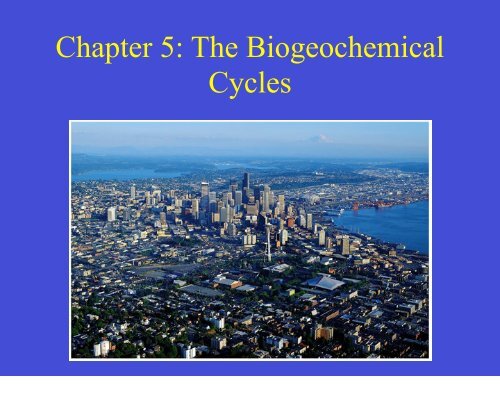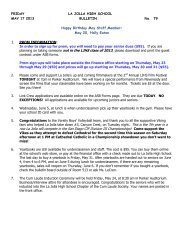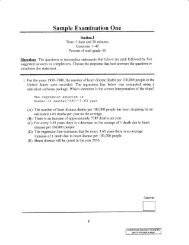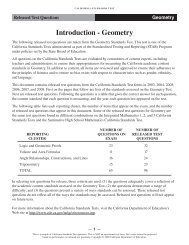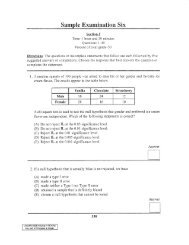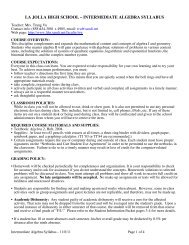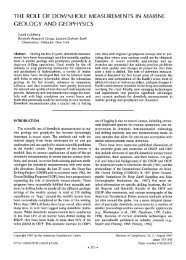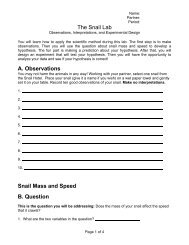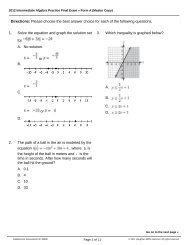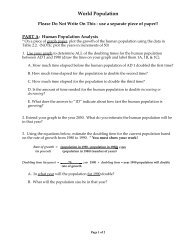Chapter 5: The Biogeochemical Cycles
Chapter 5: The Biogeochemical Cycles
Chapter 5: The Biogeochemical Cycles
Create successful ePaper yourself
Turn your PDF publications into a flip-book with our unique Google optimized e-Paper software.
<strong>Chapter</strong> 5: <strong>The</strong> <strong>Biogeochemical</strong><br />
<strong>Cycles</strong>
Local examples of<br />
<strong>Biogeochemical</strong> Cycling<br />
• Wild fires 2003<br />
• Marine habitat cycling<br />
CO 2 and Silicon<br />
• Landfill production of<br />
CH 4 (methane) from<br />
urban waste<br />
• Fresh water going out<br />
to sea and evaporating<br />
to form clouds
<strong>Biogeochemical</strong> <strong>Cycles</strong><br />
• A biogeochemical cycle is the complete<br />
path a chemical takes through the four<br />
major components of Earth’s system.<br />
– Atmosphere<br />
– Hydrosphere<br />
– Lithosphere<br />
– Biosphere
Chemical Reactions<br />
• A process in which new chemicals are<br />
formed from elements and compounds that<br />
undergo a chemical change.<br />
– E.g. rain water and carbon dioxide<br />
– H 2 O + CO 2 H 2 CO 3<br />
– Weak carbonic acid reacts w/ rock and soil
Chemical Reactions<br />
• Another example where the products are<br />
totally different despite the same reactants<br />
– Chemical reaction for photosynthesis<br />
– 6CO 2 + 6H 2 O C 6 H 12 O 6 + 6O 2
<strong>Biogeochemical</strong> cycles<br />
• Use a “box and arrow” diagram to describe<br />
the transitions<br />
• Consider a global perspective.<br />
– (ie) Global climate change from burning fossil<br />
fuels<br />
• Local scales may also be instructive<br />
– Lake Washington - effects of sewage on<br />
nutrient cycling in aquatic habitat
Chemical Reactions<br />
• Chemicals in the four major components<br />
have three different average storage times<br />
– Long in rocks<br />
– Short in the atmosphere<br />
– Intermediate in the hydrosphere and biosphere
Environmental Questions and<br />
<strong>Biogeochemical</strong> <strong>Cycles</strong><br />
• Biological Questions<br />
– What factors place limits on the abundance and<br />
growth of organisms and their ecosystem?<br />
– What toxic chemicals might be present…?<br />
– How can people improve the production of a<br />
desired biological resource?<br />
– What are the sources of chemicals required for<br />
life?<br />
– What problems occur when a chemical is too<br />
abundant?
Environmental Questions and<br />
<strong>Biogeochemical</strong> <strong>Cycles</strong><br />
• Geologic Questions<br />
– What physical and chemical processes control the<br />
movement and storage of chemical elements in the<br />
environment?<br />
– How are chemical elements transferred from solid earth<br />
to water, atmosphere, and life-forms?<br />
– How does the long term storage of elements in rocks<br />
and soils affect ecosystems on local to global scales?
Environmental Questions and<br />
<strong>Biogeochemical</strong> <strong>Cycles</strong><br />
• Atmospheric Questions<br />
– What determines the concentrations of elements<br />
and compounds in the atmosphere?<br />
– Where the atmosphere is polluted how might<br />
we alter a biogeochemical cycle to reduce<br />
pollution?
Environmental Questions and<br />
<strong>Biogeochemical</strong> <strong>Cycles</strong><br />
• Hydrologic Questions<br />
– What determines whether a body of water will<br />
be biologically productive?<br />
– When a body of water becomes polluted, how<br />
can we reduce the pollution and its effects?
Biogeochem <strong>Cycles</strong> and Life<br />
• Of the 103 known elements only 24 are<br />
required for life.<br />
– Macronutrients- required in large amounts<br />
• Big six = C, H, N, O, P, S<br />
– Micronutrients- required either in small/<br />
moderate amounts<br />
• For life to persist, elements must be<br />
available at the right time, right amount, and<br />
right concentrations relative to one another.
Biogeochem <strong>Cycles</strong> and Life<br />
• Limiting factor - For life to persist<br />
elements must be available at right time,<br />
right amount, and right concentrations<br />
relative to one another. When this does not<br />
happen, the chemical in shortest supply may<br />
become a limiting factor.
General Concepts Central to<br />
<strong>Biogeochemical</strong> <strong>Cycles</strong><br />
• Some chemical cycle quickly and are<br />
readily regenerated for biological activity.<br />
– <strong>The</strong>y typically have a gas phase, are water<br />
soluble and carried by the hydrologic cycle.<br />
• Other chemical elements are relatively<br />
immobile and returned by geological<br />
processes.<br />
– Typically they lack a gas phase and have many<br />
insoluble forms (ie. Phosphorous and Silicon)
General Concepts Central to<br />
Biogeochem <strong>Cycles</strong><br />
• Chemical w/ gas phase, that are stored in<br />
atmosphere cycle rapidly. (Oxygen)<br />
• Those w/o atmospheric phase end up in deep-ocean<br />
sediment and recycle slowly. (Silicon)<br />
• Since life evolved it has altered biogeochem cycles.<br />
• <strong>The</strong> continuation of processes that control<br />
biogeochem cycles are essential for maintenance of<br />
life.
General Concepts Central to<br />
• Modern technology has changed the transfer<br />
rate of elements into air, water, and soil.<br />
– May improve crop production but may create<br />
toxic levels of some nutrients<br />
– ie. A. Chemical fertilizers for agriculture)<br />
– B. Use of fossil fuels liberating CO 2 rapidly
<strong>The</strong> Geologic Cycle<br />
• Over the last 4.6 billion years rocks and soils has<br />
been continually<br />
– Created, maintained, changed, and destroyed<br />
– By physical, chemical, and biological processes<br />
• Geologic cycle - group of cycles that are<br />
responsible for formation and change in the<br />
lithosphere<br />
– Tectonic, hydrologic, rock, and biogeochemical
Identify Convergent, Divergent plate boundaries and transform fault boundaries - Point out the volcanic activity that accompanies these<br />
geologic structures
<strong>The</strong> Tectonic Cycle<br />
• Involves creation and destruction of the<br />
lithosphere (outer layer of Earth)<br />
– ~100 km thick and broken in to several plates<br />
– <strong>The</strong> movement of plates called plate tectonics<br />
• Plate tectonics has large scales effects<br />
– Alterations in climate<br />
– Ecological islands<br />
– Areas of volcanic activity and earthquakes
<strong>The</strong> Tectonic Cycle<br />
• Three types of plate boundaries<br />
– Divergent, convergent, transform faults<br />
• Divergent plate boundary<br />
– Occurs at a spreading ocean ridge, where plates<br />
moving away from one another<br />
– New lithosphere produced<br />
– Known as sea floor spreading, produces ocean<br />
basins<br />
Fossil records - Basin and range. This is typical of the land forms we see across the entire rocky mountain/north american continent - it was<br />
once entirely under sea water!
<strong>The</strong> Tectonic Cycle<br />
• Convergent plate boundary<br />
– Occurs when plates collide<br />
– When heavier ocean plates meet lighter<br />
continental plates a subduction zone is present<br />
and the less dense material is forced above the<br />
higher density material.<br />
– When two lighter continental plates collide a<br />
continental mountain range may form.
<strong>The</strong> Tectonic Cycle<br />
• Transform fault boundary<br />
– Occurs where one plate slides past another.<br />
– San Andreas Fault in California<br />
• Boundary of North American and Pacific plates<br />
• LA moving towards SF
<strong>The</strong> Hydrologic Cycle<br />
• <strong>The</strong> transfer of water from oceans to the<br />
atmosphere to the land and back to the<br />
oceans.<br />
– Involves evaporation of water from oceans into<br />
the atmosphere<br />
– Precipitation (rain, snow, hail) onto land<br />
– Evaporation from land to the atmosphere<br />
– Runoff from streams, rivers, and subsurface<br />
groundwater
<strong>The</strong> Hydrologic Cycle<br />
• Driven by solar energy<br />
• 1.3 billion km 3 of water on Earth<br />
– 97% in oceans<br />
– 2% in glaciers and ice caps<br />
– 0.001% in atmosphere<br />
– <strong>The</strong> rest in fresh water on land - HOW MUCH<br />
IS THAT? CAUSE THAT’S WHAT’S LEFT<br />
FOR US TO USE!!!
<strong>The</strong> Hydrologic Cycle<br />
• At the regional and local level, the<br />
fundamental unit of the landscape is the<br />
“drainage basin.”<br />
– <strong>The</strong> area that contributes surface runoff to a<br />
particular stream or river<br />
– Vary greatly in size<br />
– Usually named for main stream or river<br />
– What are some of our “drainage basins”<br />
regionally?<br />
Salton Sea, San Joaquin Valley, Santee, Lake Cuyamaca,<br />
Escondido ?????
<strong>The</strong> Rock Cycle<br />
• Consists of numerous processes that<br />
produce rocks and soils.<br />
• Depends of the tectonic cycle for energy<br />
and the hydrologic cycle for water.<br />
• Rocks classified as<br />
– Igneous<br />
– Sedimentary<br />
– Metamorphic
Period 1<br />
10/5<br />
<strong>The</strong> Rock Cycle<br />
• Physical weathering<br />
(freeze, thaw)<br />
produces sediment<br />
such as gravel, sand<br />
and silt.<br />
• Chemical weathering<br />
occurs when weak<br />
acids in water dissolve<br />
chemicals from rocks.
Grand Canyon. Layers of sedimentary<br />
rock.
Devils Slide Yellowstone<br />
Montana
<strong>Biogeochemical</strong> Cycling in<br />
Ecosystems<br />
• An ecosystem is a community of different<br />
species and their non-living environment in<br />
which energy flows and chemicals cycle.<br />
• Chemical cycling in an ecosystem begin w/<br />
inputs from outside.<br />
– Rain<br />
– Dust<br />
– Volcanic ash
<strong>Biogeochemical</strong> Cycling in<br />
Ecosystems<br />
• Chemicals cycle internally within<br />
ecosystem through<br />
– Air, water, rocks, soil and food chains<br />
– By way of physical transport and chemical<br />
reactions<br />
• Ecosystem can lose chemical elements to<br />
other ecosystems<br />
– E.g. river transport from land to sea
Ecosystem <strong>Cycles</strong> of a Metal and<br />
a Nonmetal<br />
• Different chemical elements have very<br />
different pathways.<br />
– Calcium cycle is typical of a metallic element<br />
– Sulfur cycle typical of a nonmetallic element<br />
• Metals do not have a gaseous phase.<br />
• Elements with a gas phase can be returned<br />
to ecosystem rapidly.
<strong>The</strong> Carbon Cycle<br />
• Carbon is the element that anchors all<br />
organic substances.<br />
• Carbon has a gaseous phrase<br />
– Enters atmosphere (CO 2 and CH 4 ) through<br />
respiration, fires and diffusion.<br />
– Removed from the atmosphere by<br />
photosynthesis
• Do plants contribute<br />
give off CO 2 ?<br />
• What is Carbon<br />
Capture and<br />
Sequestration?<br />
• How is Carbon<br />
involved in our marine<br />
ecosystems and<br />
geologic cycles?<br />
Carbon Cycle
<strong>The</strong> Carbon Cycle<br />
• Carbon occurs in the ocean in several forms<br />
– Dissolved CO 2 , carbonate and bicarbonate<br />
– Marine organisms and their products, CaCO 3<br />
• Enters the ocean by<br />
– Simple diffusion allows it to dissolves into water<br />
– Transfer from land via rivers as dissolved carbonates<br />
– Wind helps CO 2 become mixed into the marine water<br />
column
<strong>The</strong> Carbon Cycle<br />
• Carbon enters the biota through<br />
photosynthesis and is returned by<br />
respiration or fire.<br />
– When organisms die, decomposition releases<br />
carbon as CO 2 or Methane (CH 4 ).<br />
– Under certain conditions carbon is not be<br />
released<br />
• Transformed into fossil fuels<br />
• Deposition as marine sediments CaCO 3
<strong>The</strong> Carbon-Silicate Cycle<br />
• <strong>The</strong> cycling of carbon intimately involved with the<br />
cycling of silicon.<br />
• Weak carbonic acid falls as rain and weathers<br />
silicate rich rocks<br />
-<br />
– Releases Ca2+ and HCO3 – Silicon is transferred to oceans and used by marine<br />
animals to construct shells along with the carbonates<br />
– Shells deposited on sea floor become part of<br />
sedimentary rock layer and return to Earth’s mantle in<br />
subduction zones where volcanic eruptions may<br />
eventually lead to the release of CO2 from superheated<br />
rocks
<strong>The</strong> Carbon-Silicate Cycle<br />
• Affects the levels of CO 2 and O 2 in the<br />
atmosphere<br />
– <strong>The</strong> CO 2 is absorbed by phytoplankton while<br />
they release O 2
<strong>The</strong> Nitrogen Cycle<br />
• N is essential to life because it is necessary<br />
for the production of proteins and DNA.<br />
• Free N 2 makes up 80% of atmosphere<br />
– But most organisms can’t use it directly<br />
– N 2 is a relatively unreactive element that must<br />
be converted to NO 3 - or NH4 + (performed by<br />
bacteria)
<strong>The</strong> Nitrogen Cycle<br />
• Nitrogen fixation- process of converting<br />
atmospheric N to NO 3 - or NH4 +<br />
• Denitrification- process of releasing fixed N<br />
back to molecular N<br />
• Almost all organisms depend on N<br />
converting bacteria<br />
– Some have formed symbiotic relationships in<br />
the roots of plants or stomach on animals
<strong>The</strong> Nitrogen Cycle<br />
• Industrial process can now convert molecular N 2<br />
into compounds usable by plants.<br />
- +<br />
– Main component of N fertilizers (NO3 and NH4 )<br />
– N in ag runoff potential source of water pollution<br />
• N combines w/ O 2 at high temperatures<br />
– Oxides of N are a source of air pollution (NO (gas) and<br />
NO 2 (gas) )
<strong>The</strong> Phosphorus Cycle<br />
• P is one of the “big six” required for life<br />
– Often a limiting factor for plant and algal<br />
growth<br />
• Does not have a gaseous phase<br />
– Rate of transfer slow
<strong>The</strong> Phosphorus Cycle<br />
• Enters biota through uptake as phosphate by<br />
plants, algae and some bacteria.<br />
– Returns to soil when plants die or is lost to oceans via<br />
runoff<br />
– Returned to land via ocean feeding birds (guano)<br />
• Guano deposits are a major source of P for<br />
chemical fertilizers (<strong>The</strong>y are present in<br />
geologically large quantities in Chile and a few<br />
other deposits in the world.)
Mining guano in<br />
Florida


